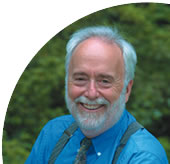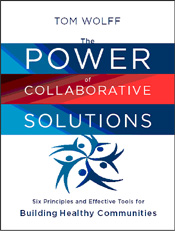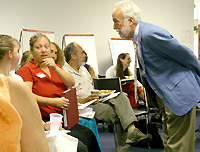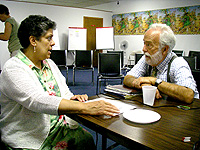Great New Resource on Health Equity April 25, 2011
Posted by tomwolff in : Uncategorized , add a commentHealth equity is the hot new topic of interest – it is one of the four top goals of HHS’ Healthy People 2020. However many groups approach this critical topic with limited vision. Not so the article entitled “Building a Regional Health Equity Movement: The grantmaking model of a local health department” (click for full article HERE).
This fascinating article describes the work of the Boston Public Health Commission’s Office of Health Equity and Social Justice. They take a broad social determinants approach to reduce racial and ethnic inequities that is based on overtly addressing racism, building local coalitions, community engagement for those most affected by the issues, moving from social services to social change and focusing on policy change.
Seeing is believing – read the article and let me know what you think by clicking on Add a Comment above. Thanks
Add a commentLook at what’s in this month’s APA Monitor April 12, 2011
Posted by tomwolff in : Uncategorized , add a commentI was very pleased to see that the April 2011 issue of the American Psychological Association Monitor (their trade news magazine that goes to all ….. members) featured an article entitled “Bringing Communities Together” which looks at my coalition and community building work. Often when you talk to reporters you are not too sure what will emerge. In this case Kirsten Weir did a great job in taking a long rambling interview and consolidating it into a brief engaging story. Take a look and let me know what you think….
http://www.apa.org/monitor/2011/04/communities.aspx
Add a commentThe Reviews Are Starting to Come In April 4, 2011
Posted by tomwolff in : Uncategorized , add a commentWhen you have a book published like The Power of Collaborative Solutions it is so hard to know what people actually think of it . So it is fun when the reviews finally start to come in. I am pleased to be able to share with you some of the new reviews of my book that have been emerging in recent issues of professional journals:
Bill Berkowitz in the January 2011 issue of The National Civic Review
“Tom Wolff’s The Power of Collaborative Solutions does in fact give us something different and new, in two major respects; one in its practical teaching, the other in its specific content. Both are distinctive, making this book well worth the attention of any community or civic affairs leader”
For full review:HERE
Adrienne Paine Andrews in the January 2010 issue of the Global Journal of Community Psychology Practice www.gjcpp.org
“Tom Wolff provides a passionate and convincing case for using collaborative approaches to address our most intractable community problems. He offers personal reflection, case studies and tools based on his extensive experience to help us move toward more effective, sustainable, and collaborative solutions.”
Full review HERE
Brad Olsen in the April 2011 Issue of The Community Psychologist
“The book is filled with tips, theoretical orientations, and practical tools. One regularly encounters sections of the text and says, “Yes, I’ll have to try that in my next dialogue with X organization. That could be useful.”
Full Review HERE
Add a comment
Is your community happy? stressed? Find out here. March 24, 2011
Posted by tomwolff in : Uncategorized , add a commentCheck out this amazing website from the NY Times where you can discover relative levels of happiness, stress, obesity, job satisfaction, community satisfaction, etc by Congressional District. A fun and very useful site.
http://www.nytimes.com/interactive/2011/03/06/weekinreview/20110306-happiness.html
Add a commentThich Nhat Hanh’s message for Japan March 18, 2011
Posted by tomwolff in : Uncategorized , add a commentThich Nhat Hanh’s Message to Japan
Dear friends in Japan,
As we contemplate the great number of people who have died in this tragedy, we may feel very strongly that we ourselves, in some part or manner, also have died.
The pain of one part of humankind is the pain of the whole of humankind. And the human species and the planet Earth are one body. What happens to one part of the body happens to the whole body.
An event such as this reminds us of the impermanent nature of our lives. It helps us remember that what’s most important is to love each other, to be there for each other, and to treasure each moment we have that we are alive. This is the best that we can do for those who have died: we can live in such a way that they continue, beautifully, in us.
Here in France and at our practice centers all over the world, our brothers and sisters will continue to chant for you, sending you the energy of peace, healing and protection. Our prayers are with you.
Thich Nhat Hanh
Add a commentWhat are we thinking? $44 billion in cuts to the vulnerable vs. $42 billion in tax cuts for the wealthy March 17, 2011
Posted by tomwolff in : Uncategorized , add a comment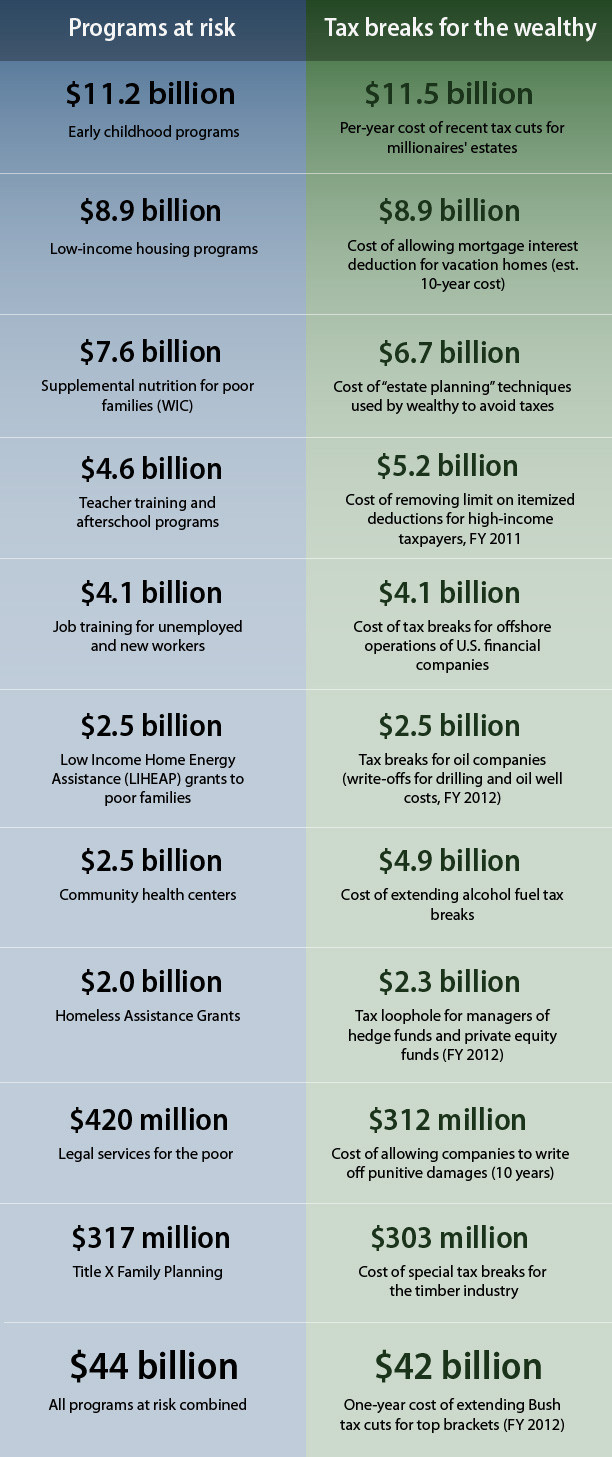
Here is a great chart that compares $44 billion in cuts to services for the most vulnerable Americans including early childhood, job training, heating assistance, community health centers, low income housing , WIC against $42 billion in tax cuts for the wealthiest Americans. What are people thinking? Or are they?
Comments?
Add a commentJamaica Plain Youth Health Equity Coalition Report March 10, 2011
Posted by tomwolff in : Uncategorized , add a comment
For the last few years I have the honor, pleasure and challenge of working with the Boston Public Health Commission’s Office of Health Equity and Social Justice on their racial health equity programs. http://www.bphc.org/chesj/Pages/default.aspx
Specifically I have been the coalition building, community development consultant to about a dozen of the community sites that they have funded.
The Jamaica Plain Youth Health Equity Collaborative http://www.facebook.com/group.php?gid=193620544737 has been an especially active and productive coalition. The Jamaica Plain Youth Health Equity Collaborative, a group of youth, health care, housing, education, and youth serving organizations, met for over a year to look at six social determinants of health areas or BUCKETS that impact young people who live, work, and play in Jamaica Plain. The six determinants were housing, education, employment, health care, food and fitness and safety.
Out of this work emerged the Jamaica Plain Youth Report. http://www.bphc.org/chesj/resources/Documents/Reports/JP%20Report.pdf
Each section of the report addresses one of the buckets (social determinants of health) and includes material generated by the young people themselves that cover:
– A real youth experience of life in JP (names have been changed)
– Data that supports the real experiences of youth in JP
– A connection to health outcomes and systemic/institutional racism identified by the youth
– A list of local organizations where good work on this issue is being done
– Suggestions for action
The report was written for the youth of the community. The cover of the report has a picture of a “Teeny” which is a drink that is very available in the JP stores that cater to JP’s African American and Latino communities. The main characteristic of a Teeny is that it is 100% full of nothing that is good for you (mainly sugar, flavoring, water and coloring). It is usually replaced by real juice in the stores in the more affluent White parts of JP. It is thus a great symbol of the social determinants of health. Under the picture of the Teeny on the cover it says “If you know what this is, this report if for YOU”
The report was mainly the creative work of Meghan Wood (megleewood@gmail.com).
Check it out – it is an impressive and engaging product and can be an inspiration for other communities.
http://www.bphc.org/chesj/resources/Documents/Reports/JP%20Report.pdf
They hope that in the hands of young people, their families, and the organizations that serve them, this report will aid in the fight to create a more equitable JP and Boston.
I have been inspired by the work of the JP Youth Health Equity Collaborative and their leader, Abigail Ortiz, and you will too. Take a look and then let us know what you think. Could you do something like this your community? COMMENT HERE.
Add a commentDoing Democratic Governance Right February 24, 2011
Posted by tomwolff in : Uncategorized , add a commentThis came across my desk from my good friend and colleague Bill Berkowitz and it is well worth checking out:
We find lots of helpful news in our inbox, but here’s one item that stands out. It’s a report titled “Beyond Civility: From Public Engagement to Problem Solving,” released just last month by the National League of Cities. Designed as “an action guide for city leaders,” it’s short (12 pages), research-based, and to the point.
The report offers seven principles for “doing democratic governance right.” More important, it gives multiple specific examples of how other communities are putting these principles into practice. Perhaps you could adapt some of these ideas for your own community.
You can find the report at:
http://www.nlc.org/ASSETS/B5FAD9F7F4B84A2E93D8DB388FA8C700/RI_CivilityGuide2010_FINAL.pdf
The League has published many other reports along the same lines, and you might want to check these out as well while you’re at its main site, www.nlc.org.
The report presents seven principles to help city leaders build a culture of democratic governance in their communities:
MODEL CIVILITY
SHARPEN SKILLS
CREATE OPPORTUNITIES FOR INFORMED ENGAGEMENT
SUPPORT A CULTURE OF COMMUNITY INVOLVEMENT
MAKE THE MOST OF TECHNOLOGY
INCLUDE EVERYBODY
MAKE IT LAST
To add a comment CLICK HERE
Add a commentCommunity Tool Box Out of the Box Prize Winners Announced February 17, 2011
Posted by tomwolff in : Uncategorized , add a commentRecognizing grass-roots efforts to improve the lives of impoverished, marginalized populations around the globe was the goal of the first Out of the Box competition organized by the University of Kansas Work Group for Community Health and Development. Selected by an international panel of judges and then by public voting, the grand prize and second prize- winning projects are both located in Kenya in communities ravaged by civil unrest and the HIV/AIDS epidemic.
The $5000 grand prize winner is the Uhuru Child organization for its Jikaze Internally Displaced Persons Resettlement Village Project in Maai Mahiu, Central Province, Kenya. The project a sustainable re-settlement village for 900 internally displaced persons following the Kenyan post-election violence in 2008.
The village lacked consistent food and clean water supplies, access to health care, sufficient classrooms and funds for education. Half of the villagers were still living in tents. Within a year the group built 56 houses, planted 145 trees, sold 75 water filters at a subsidy, conducted three months of food relief in conjunction with the dispersal of 90 micro-finance loans and offered 22 educational scholarships to children in the community. As a result, every family has been moved out of tents and into houses, and no one has died of starvation, sickness or accident since the initiative began, according to Joe Heritage, Uhuru Child’s Project Manager. Since the distribution of the water filters, no child has become sick from water-borne diseases. Uhuru Child is an international community support organization that divides its efforts between America and Africa.
Uhuru Child tells their story in a beautiful and compelling video.
The $2,000 second prize winner, Fountain of Hope Youth Initiative, is a community-based social support organization that helps children, especially those affected by HIV/AIDS, have equal opportunity to compete academically and in extracurricular activities.
In 2007, the organization began to supply girls with sanitary pads in Kiambu, Kenya. Community workers discovered that the lack of sanitary pads was often the reason that girls from poor homes were struggling academically or even dropping out of school. The girls were often embarrassed and even ridiculed because of staining their uniforms during menstruation. Fountain of Hope organized donations of sanitary pads from community shops and supermarkets starting by asking for just a single packet of sanitary pads, according to James N. Waruiru, Fountain of Hope’s Project Coordinator. The initiative now supports more than 250 young women.
More than 300 projects in 42 countries – from Argentina to Zimbabwe – applied for the prizes that recognize outstanding community innovation efforts that stress low-cost, small-scale, non-technical solutions to local problems.
According to Stephen B. Fawcett, director of the Work Group for Community Health and Development that sponsors the Community Tool Box, the sheer number of projects submitted to the contest testifies to how much community innovation is underway in the far corners of the world. “The power of communities to take action is a wonderful thing to behold. The competition made it possible for people around the world to share what works and to inspire others to take action.”
For more details, and to view stories of others who are trail-blazing to improve life for people in their communities, we welcome you to visit the new Community Innovators’ page of the Community Tool Box. We hope that you will check back often, as we will be featuring additional stories of inspiration and change throughout the year.
You can add your COMMENTS HERE
Add a commentIs the grassroots community at your partnership table? February 7, 2011
Posted by tomwolff in : Uncategorized , add a commentI was recently leading a webinar for a new Federal initiative. Their focus is on health issues identified by the community as adversely affecting the health of women and girls. In the first phase of funding they were to spend a year doing a community needs assessment.
One major focus of my presentation was the necessity of engaging those most affected by their issues in all aspects of the project, not just the assessment but also program planning, implementation, and evaluation.
We had a lively exchange on this topic – who were those most affected by the issues they were assessing? Were they already at the partnership table? If not how could they get them there? And how could they keep them there? I also asked what actual roles will those most affected play in the partnership. To answer this last question I use a variation of the Arnstein Ladder of Participation that asks us to rate our level of engagement of the grassroots on a continuum from tokenism and decoration (lowest level) to shared decision making (highest level). (See The Power of Collaborative Solutions page 98-99). This made for a fascinating discussion.
These are all good questions to ask for your own work. These particular projects were very engaged in actively addressing these issues and getting the community to the table.
How would you answer these questions for your own community work?
For me it highlighted once again how much we in community health and development espouse the idea of having the grassroots at the table as equal partners and how seldom we actually practice it.
How often do you sit at a partnership /coalition/collaboration table and actually see a decent number of representatives from what we often call the “target population” or those most affected by the issue? (By the way – how would you like to be called a “target population”?)
How often does any one in your community go door-to-door in your neighborhoods and ask the residents what they see as the issues and what they see as the strengths of their community? And how they can work with us to solve the emerging issues? In my experience this is happening less and less. Why is that? How can we function effectively without doing the above?
I am very concerned that we are not talking with those most affected because it means we can’t possibly truly understand their issues, find the appropriate solutions, get community buy-in to the solutions and finally hope for any community sustainability. All these steps are crucial to successful intervention and all REQUIRE having the community at the table with us.
As community organizers and developers we used to actually be on the streets and in the neighborhoods, what happened?
In one of my next blogs I will talk about four possible solutions,
Do you have the grassroots community at the table for your work? How did you make that happen? How can we all bring the community to the table for shared decision making?
To add a comment Click Here

